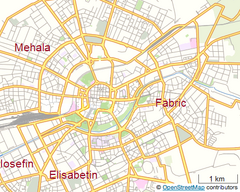Water Tower in Fabric
| Water Tower in Fabric | |
|---|---|
Turnul de apă din Fabric | |
 | |
 Water Tower in Fabric Location within Timișoara | |
| General information | |
| Type | Water tower |
| Location | Timișoara |
| Address | 16 Samuil Micu St |
| Country | Romania |
| Coordinates | 45°45′57″N 21°15′04″E / 45.76587°N 21.25105°E |
| Construction started | 1912[1] |
| Completed | 1914[1] |
| Client | The Water-Canal Company of Timișoara |
| Owner | "1 Iunie" Textile Company |
| Height | 52 m |
| Design and construction | |
| Architect | János Lenarduzzi (1865–1916), Richárd Sabathiel (1875–1942) |
The Water Tower in Fabric is an industrial monument from Timișoara, Samuil Micu Street, no. 16. It was one of the sources of water supply in Timișoara at the beginning of the 20th century.[2] It is classified as a National Heritage Site (Romanian: monument istoric) with LMI code TM-II-m-A-06122.
History[]
The first reference to a well dug inside the Huniade Castle dates back to 1551. Nevertheless, as Evliya Çelebi described, for a long time Timișoara has been supplied with water from the Bega River. The matter was also confirmed by Henrik Ottendorf, who visited Timișoara in 1660 and later in 1663.[2][3]
After Timișoara had been conquered by the Habsburgs in 1729, an aqueduct began to be built. It was supposed to bring water from Giarmata, but the plan was abandoned. In 1732, a pumping station designed to pump water from Bega and filter it through several layers of sawdust was built on the place where today we can find the marketplace Bishop Alexandru Sterca-Șuluțiu. In 1774, engineer Alexander Steinlein designed and built there a water tower to supply the city with water. It was destroyed during the 1849 siege; therefore the town was then supplied with water only from wells.[4][2]
In 1891, after the demolition of Timișoara Fortress, the idea of a water supply system and drainage resembling those in other European cities was set in motion and many projects were initiated, some of them, between 1904 and 1907, by . After researching the systems in Dresden, Berlin, Hamburg, Cologne, Strasbourg, Karlsruhe and London, engineers János Lenarduzzi (1865–1916[5]) and Richárd Sabathiel (28 January 1875, Budapest – 14 June 1942, Budapest[6]) executed a project countersigned by Stan Vidrighin, who had calculated the necessities and possibilities and had drawn up the task planner.[2][7][8][9]

After the drainage system had been finished and the first Water Plant had come into use, two towers were built at the two ends of the distribution system between 1912 and 1914, with the aim of compensating the consumption level during the day.[7][10] The 52-meter-tall towers are on the historical monuments list of Timișoara.,[11] Water Tower in Fabric was equipped with a 500 m3 tank of drinking water.[7]
After World War II, more water plants came into use and the towers were no longer necessary for their initial purpose.[12] Drinking water was provided by more than 100 drilled wells,[13] which extracted water from 100 to 250 m underground.[14]
Now, at the beginning of the 21st century, the Water Tower in Fabric belongs to the "1 Iunie" textile factory (bankrupt in 2017). Both water towers are now run-down and there have been suggestions that the space between them be used for restaurants, cafés, museums, exhibition space, etc.[12]
See also[]
References[]
- ^ a b Mihai Opriș (1987). (in Romanian) Timișoara: Mică monografie urbanistică, București: Ed. Tehnică, p. 148
- ^ a b c d (in Romanian) Turnurile de apă, timisoara-info.ro, access date: 30 March 2017
- ^ Vlaicu, Hațegan, pp. 19–21
- ^ Vlaicu, Hațegan, pp. 22–24
- ^ (in Hungarian) A Farkasréti temető 2003-ban, access date: 30 March 2017
- ^ (in Hungarian) Magyar Életrajzi Lexikon 1000–1990, oszk.hu, access date: 30 March 2017
- ^ a b c Vlaicu, Hațegan, pp. 44–46
- ^ (in Romanian) Mihai Opriș, Mihai Botescu, Arhitectura istorică din Timișoara, Timișoara: Ed. Tempus, 2014, ISBN 978-973-1958-28-6, p. 254
- ^ (in Romanian) Turnul de Apa din Fabric, timisoara-info.ro, access date: 30 March 2017
- ^ (in Romanian) Turnul de apa Iosefin din Timișoara, hoinari.ro, access date: 31 March 2017
- ^ (in Romanian) Turnul de Apă din Iosefin va fi refăcut, în caz contrar Primăria riscă să plătească „taxa pe paragină”, radiotimisoara.ro, 10 January 2017, access date: 31 March 2017
- ^ a b (in Romanian) Stefan Both, Turnurile de apă, cele mai înalte structuri din Timișoara, spații inedite pentru Capitala Culturală Europeană din 2021, adevarul.ro, 26 September 2016, access date: 30 March 2017
- ^ (in Romanian) Daniela Damian, Încă zece fântâni publice în Timișoara. Zonele unde vor fi forate, renasterea.ro, 10 August 2015, access date: 30 March 2017
- ^ (in Romanian) Gheorghe Ilaș, Apă potabilă în fântânile Timișoarei, romanialibera.ro, 18 June 2007, access date: 30 March 2017
Further reading[]
- Ilie Vlaicu, Ioan Hațegan (2012). (in Romanian) Alimentarea cu apă a Timișoarei: istorie, prezent și perspective, Timișoara: Ed. Brumar 2012, ISBN 978-973-602-813-7 (online version)
External links[]
- Water tower in Fabric on YouTube at Gazeta de Vest diary
- Image gallery of student projects
- Buildings and structures in Timișoara
- Historic monuments in Timiș County
- 1914 establishments
